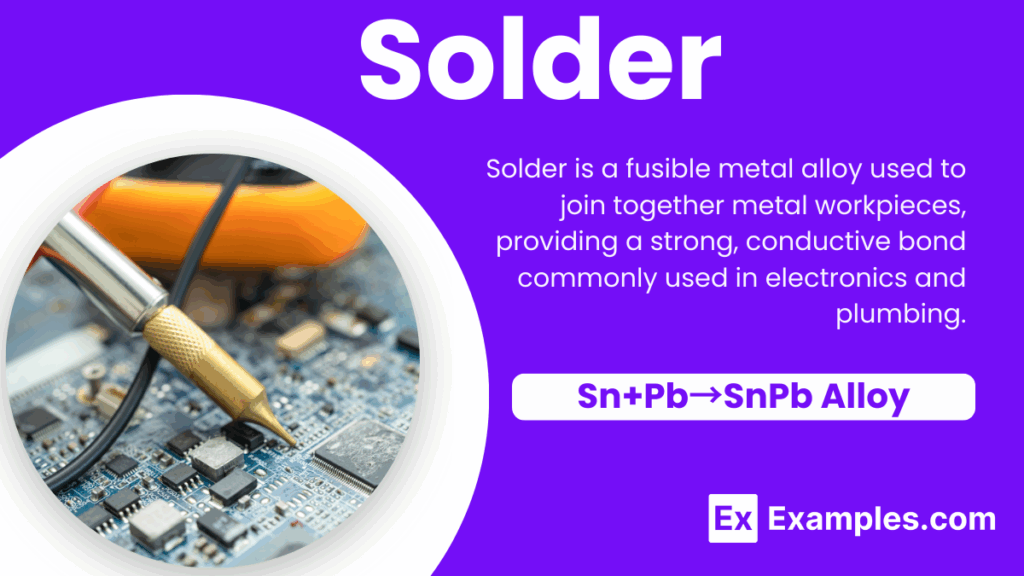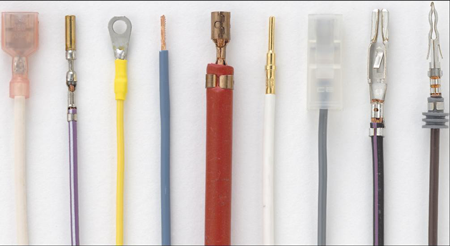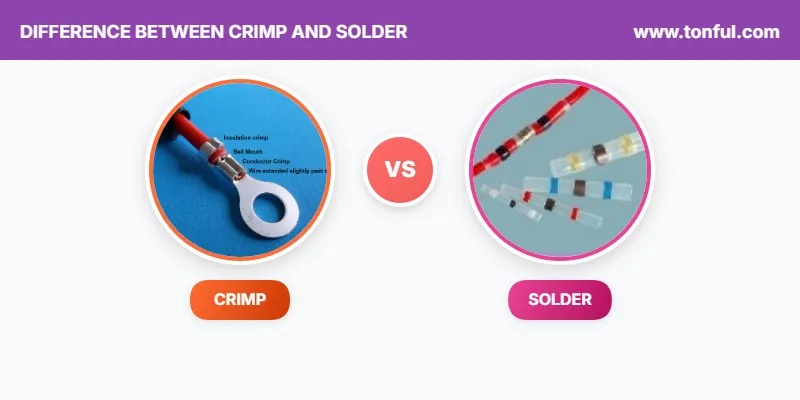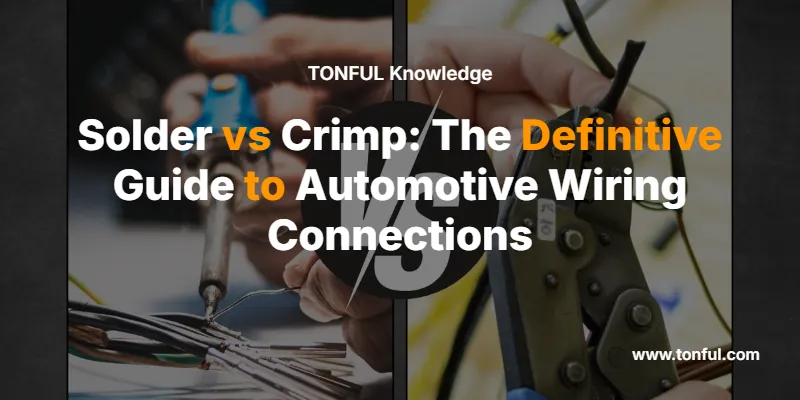For automotive wiring, crimp connections are generally preferred over solder due to their superior vibration resistance, faster installation, and better moisture resistance when done properly. However, the choice between solder and crimp depends on your specific application, skill level, and environmental conditions.
What Are Solder and Crimp Connections?
Soldering Definition

Soldering joins two metal conductors using a melted filler metal (solder) that bonds to both surfaces when cooled. In automotive applications, you heat the wire and connector with a soldering iron, apply rosin-core solder, and create a permanent metallurgical bond.
Crimp Connection Definition

Crimping mechanically deforms a metal connector around stripped wire using specialized crimping tools. The connector’s metal sleeve compresses onto the wire strands, creating a gas-tight seal that maintains electrical conductivity through mechanical pressure rather than metallurgical bonding.
Key Differences: Solder vs Crimp for Automotive Use

| Factor | Solder | Crimp |
|---|---|---|
| Vibration Resistance | Poor – brittle joints crack | Excellent – flexible connection |
| Installation Speed | Slow (3-5 minutes per joint) | Fast (15-30 seconds per joint) |
| Moisture Resistance | Poor without additional sealing | Excellent with proper terminals |
| Temperature Range | Limited by solder melting point | -40°F to 200°F+ depending on terminal |
| Skill Required | High – technique critical | Moderate – proper tool selection key |
| Reversibility | Difficult to undo | Irreversible without cutting |
| Tool Cost | $20-50 for basic setup | $30-200 for quality crimpers |
| Joint Reliability | High if done correctly | Very high with proper technique |
Applications: When to Use Each Method
Best Uses for Crimping
- Engine bay connections – Superior heat and vibration resistance
- Chassis grounding points – Reliable long-term conductivity
- Factory harness repairs – Matches OEM connection methods
- High-current applications – Better current carrying capacity
- Wet environment connections – Moisture resistance with sealed terminals
- Production work – Faster installation for multiple connections
Best Uses for Soldering
- Dashboard wiring – Low vibration environment
- Audio system connections – Signal quality considerations
- PCB repairs – Component-level work
- Custom gauge installations – Clean, professional appearance
- Low-current control circuits – Precise electrical characteristics
- Prototype work – Easy modification and testing
Purpose and Benefits of Each Method
Why Choose Crimping?
Primary Benefits:
- Vibration resistance – Flexible connection point absorbs engine movement
- Speed of installation – Critical for production or repair shop efficiency
- Moisture protection – Sealed terminals prevent corrosion
- Temperature stability – No melting point limitations
- Consistent quality – Less technique-dependent than soldering
Compliance Advantage: Most automotive manufacturers specify crimp connections in their service manuals because they meet SAE J1128 and SAE J163 standards for automotive electrical systems.
Why Choose Soldering?
Primary Benefits:
- Electrical performance – Lower resistance when done correctly
- Permanent connection – Cannot work loose over time
- Compact joints – Takes less space than bulky crimp terminals
- Signal integrity – Preferred for sensitive electronic circuits
- Professional appearance – Clean, finished look when heat-shrunk
Technical Advantage: Solder creates a metallurgical bond that can have lower electrical resistance than mechanical crimp connections.
How to Choose: Selection Guide for Automotive Wiring
Environmental Considerations
Choose Crimp When:
- Operating temperature exceeds 150°F regularly
- High vibration environment (engine, transmission, suspension)
- Potential moisture exposure exists
- Connection may need service access
Choose Solder When:
- Protected interior environment
- Low vibration area (dashboard, trunk)
- Signal quality is critical
- Space constraints exist
Application-Specific Guidelines
Engine Bay Wiring
Recommendation: Crimp – Use marine-grade heat-shrink crimp terminals rated for 200°F minimum. The constant vibration and temperature cycling make solder joints prone to failure.
Audio System Connections
Recommendation: Depends on location
- Trunk/interior: Solder acceptable for signal wires
- Engine bay: Crimp for power connections
- Door panels: Crimp to handle door movement
Lighting Circuits
Recommendation: Crimp – Use insulated crimp terminals with marine-grade heat shrink. Headlight and tail light circuits experience vibration and moisture exposure.
Gauge and Accessory Installation
Recommendation: Mixed approach
- Power feeds: Crimp with proper fusing
- Signal wires: Solder acceptable in protected areas
- Ground connections: Always crimp to chassis
Expert Tips for Success
💡 Crimping Best Practices
- Use the right tool – Ratcheting crimpers ensure consistent compression
- Match wire gauge to terminal – Critical for proper connection
- Strip to exact length – Usually 1/4″ to 3/8″ depending on terminal
- Apply dielectric grease – Prevents corrosion in harsh environments
- Heat shrink everything – Additional moisture and strain protection
💡 Soldering Best Practices
- Use rosin-core solder – Never acid-core in automotive applications
- Pre-tin both surfaces – Ensures good wetting and bond strength
- Heat the joint, not the solder – Proper thermal management critical
- Add flux for difficult joints – Improves wetting on oxidized surfaces
- Always heat shrink – Mechanical protection and moisture seal
💡 Professional Selection Criteria
- Follow OEM specifications – Check service manual requirements
- Consider service accessibility – Crimps easier to inspect and replace
- Match current capacity – Use proper wire gauge calculations
- Plan for expansion – Leave service loops and access points
⚠️ Critical Safety Warnings
Electrical Safety
- Always disconnect battery before working on any automotive electrical system
- Use proper PPE – Safety glasses when crimping, ventilation when soldering
- Verify wire gauge capacity – Undersized wires create fire hazards
- Install proper fusing – Never bypass or upsize fuses
Code Compliance
- Follow SAE standards – J1128 for wire, J163 for terminals
- Meet local regulations – Some jurisdictions have specific requirements
- Use UL-listed components – Especially important for aftermarket installations
- Document modifications – Required for some insurance and safety inspections
Common Problems and Solutions
Crimping Troubleshooting
Problem: High resistance connections
- Cause: Wrong crimper or insufficient compression
- Solution: Use proper ratcheting crimper, verify terminal rating
Problem: Corrosion at connection point
- Cause: Moisture ingress or dissimilar metals
- Solution: Use sealed terminals with dielectric grease
Soldering Troubleshooting
Problem: Cold solder joints
- Cause: Insufficient heat or contaminated surfaces
- Solution: Clean thoroughly, use proper iron temperature (350-375°F)
Problem: Joint failure from vibration
- Cause: Rigid connection in high-movement area
- Solution: Add strain relief or switch to crimp connection
Quick Reference Guide
Wire Gauge to Terminal Size Chart
| Wire Gauge | Crimp Terminal Size | Solder Iron Wattage |
|---|---|---|
| 22-18 AWG | 22-18 terminals | 25-30W |
| 16-14 AWG | 16-14 terminals | 30-40W |
| 12-10 AWG | 12-10 terminals | 40-60W |
| 8 AWG | 8 gauge terminals | 60-80W |
Essential Tool Checklist
For Crimping:
- Ratcheting crimper (proper gauge range)
- Wire strippers with gauge markings
- Heat gun for shrink tubing
- Dielectric grease
- Various crimp terminals and shrink tubing
For Soldering:
- Temperature-controlled iron (30-60W)
- Rosin-core solder (60/40 or 63/37)
- Flux paste for difficult joints
- Heat shrink tubing assortment
- Helping hands or PCB holder
Professional Recommendations
When to Call a Professional
- High-current installations (alternators, starters, winches)
- Safety-critical systems (ABS, airbag, engine management)
- Insurance requirements – Some modifications require certified installation
- Warranty considerations – Professional work may preserve coverage
Certification and Training
- IPC certification – Industry standard for soldering training
- ASE electrical certification – Automotive service excellence
- Manufacturer training – Brand-specific requirements and techniques
Frequently Asked Questions
What makes crimp connections better for automotive use?
Crimp connections excel in automotive applications because they remain flexible under vibration, resist moisture when properly sealed, and maintain consistent electrical properties across temperature extremes. The mechanical connection doesn’t rely on a metallurgical bond that can crack or fail under stress.
Can you solder automotive wiring safely?
Yes, soldering automotive wiring is safe when done correctly with proper materials and techniques. Use rosin-core solder, ensure good ventilation, disconnect the battery, and always add heat shrink protection. However, avoid soldering in high-vibration areas like the engine bay.
Which method provides lower electrical resistance?
A properly executed solder joint typically has lower electrical resistance than a crimp connection. However, the difference is negligible in most automotive applications, and crimp connections offer superior mechanical reliability in vehicle environments.
What tools do I need for professional-quality crimping?
For professional results, invest in a ratcheting crimper designed for your wire gauge range, precision wire strippers, a variety of marine-grade terminals, adhesive-lined heat shrink tubing, and dielectric grease for corrosion protection.
Are there legal requirements for automotive wiring methods?
While no federal laws mandate specific wiring methods for personal vehicles, insurance companies and local jurisdictions may have requirements. Always follow manufacturer service procedures and SAE standards (J1128, J163) for safety and compliance.
How do temperature extremes affect each connection type?
Crimp connections handle temperature extremes better because they don’t rely on a material with a specific melting point. Quality crimp terminals are rated from -40°F to 200°F or higher. Solder joints can fail if the solder melts, typically around 300-400°F depending on alloy.
What’s the best approach for repairing factory harnesses?
For factory harness repairs, crimping is preferred because it matches OEM construction methods and provides the vibration resistance designed into the original system. Use terminals that match the original connector types and wire gauge specifications.
Can mixing solder and crimp connections cause problems?
Mixing connection types in the same circuit won’t cause electrical problems, but it can create maintenance challenges. Different expansion rates between solder and crimp joints may cause stress points. For consistency and serviceability, choose one primary method per circuit.

